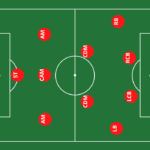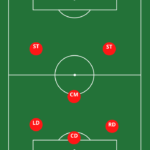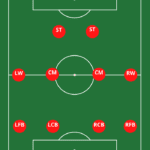- Last Updated -
The Importance of Breaking in Soccer Cleats
Let’s dive in – how to break in soccer cleats!
Soccer is a game that requires precision, agility, and speed. Wearing the right cleats can make all the difference in your performance on the field. However, new cleats can be stiff and uncomfortable, making it difficult to play at your best. That’s why you will learn how to break in your soccer cleats in this article.
That’s why breaking in your cleats is essential for optimal performance and comfort. Breaking in your soccer cleats involves gradually molding them to fit the shape of your feet.
This process helps to reduce discomfort and prevent blisters while ensuring that you have maximum control over the ball with every touch. One of the biggest mistakes players make is wearing their new cleats straight out of the box during a game or practice session.
This can lead to painful blisters and potentially even long-term foot injuries. To avoid this, it’s important to take things slow and gradually break in your new soccer cleats over time.
Affiliate Disclosure: Some of the links in this article may be affiliate links, which can provide compensation to me at no cost to you if you decide to purchase.

See best of soccer cleat articles below

The Importance of Sizing and Style
Before even thinking about breaking in your new soccer cleats, it’s important to make sure you have the right size and style. Wearing cleats that are too small or too big can lead to discomfort and even injuries.
Make sure to measure your feet before making a purchase, as sizing can vary between brands. Additionally, consider the style of cleat that will work best for you.
Think about the playing surface (grass, turf, etc.) and your position on the field when selecting a style. For example, forwards may prefer a cleat with more traction for quick cuts and acceleration.
Lacing Up Your Cleats
Properly lacing up your soccer cleats is crucial for both comfort and performance. Start by loosening all of the laces so that you can easily slide your foot into the shoe without damaging any of the materials.
Once your foot is in the shoe, begin lacing up from the toe area, ensuring that each lace is pulled tightly but not too tight. As you move up towards the ankle area, you may want to adjust the tightness based on your personal preference.
Tie a secure knot at the top of each lace. Some players choose to tie their laces around their ankles for added support – this is known as a “lace lock.” Experiment with different lacing methods until you find what works best for you.
By taking these steps before breaking in your new soccer cleats, you’ll be setting yourself up for success on the field. Don’t rush through this process – take time to ensure that everything fits properly and feels comfortable before starting any training or games.
Wear Them Around the House
The Comfort Test
The first step in breaking in your soccer cleats is to begin wearing them around the house. The primary goal of this stage is to see if they’re comfortable enough for extended wear. You don’t want any blisters, hotspots, or sore spots on your feet during games.
So, start by putting them on and walking around your house for short periods. Don’t wear them for more than 10-15 minutes at a time initially.
Avoid Running or Playing Soccer
It’s important to avoid running or playing soccer in new cleats during this phase because you can create unnecessary wear and tear before you achieve full comfort. Just focus on walking around the house, standing up, and sitting down as much as possible with your new cleats on.
Gradually Increase Wearing Time
Once you feel comfortable walking around with the cleats on, gradually increase the amount of time you wear them. Aim to wear your soccer cleats indoors for an hour at a time before taking them off again.
This stage is crucial because it allows your feet to get used to the shoes’ shape and also helps break in their materials. By following these steps, you will ensure that your soccer cleats are broken in adequately before using them out on the pitch.
Take your time with this process; there’s no need to rush it! Remember that patience is key when breaking in new shoes – especially ones that will be worn during high-intensity activities like soccer games!
Short Practice Sessions
Gradually Increasing Wear Time
One of the best ways to break in soccer cleats is through gradual wear and tear. Begin by wearing them for short periods during practice sessions.
This will allow your feet to adjust to the new shoes without overwhelming them with an extended period of use that could cause blisters and discomfort. Start with 30 minutes during one practice session, then gradually increase the time until you can wear them comfortably for an entire game or match.
Focus on Basic Movements
During these short practice sessions, it’s important to focus on basic movements like dribbling, passing, and shooting. These exercises will help your feet get used to the cleats’ shape and contours while also developing your ball-handling skills. Don’t try any fancy moves before properly breaking in your cleats – stick with simple drills until they feel comfortable.
The Importance of Socks
Wearing proper soccer socks is also crucial when breaking in new cleats. Thick socks provide a buffer between your feet and shoes, which can help prevent blisters and discomfort during the break-in process.
Make sure that your socks fit well and are made from breathable materials that allow air circulation inside the shoe. During this stage of breaking in soccer cleats, patience is key.
Take things slowly and focus on getting comfortable with basic movements before moving on to more advanced drills or game-time action. With proper care and patience, you’ll soon be ready to take on any opponent with confidence!
Increase Intensity
Suggest ramping up the intensity by incorporating more advanced drills and movements into practice sessions
Once you’ve been wearing your cleats around the house and during short practice sessions, it’s time to start increasing the intensity of your workouts. This means incorporating more advanced drills and movements into your soccer practices.
Some good drills to try include practicing quick turns, advanced footwork, and ball control drills. These types of exercises will help you get used to moving in your new cleats while also building endurance.
Emphasize the importance of listening to your body and not pushing too hard too soon
As you start ramping up the intensity of your workouts, it’s important to listen to your body. While it’s normal to feel some discomfort or tightness in new cleats, if you experience pain or sharp discomfort while practicing, stop immediately. Continuing to play through pain can lead to injuries that could keep you off the field for weeks or even months.
When breaking in soccer cleats, take things slowly – there’s no need to rush the process. It’s better to build up gradually rather than trying too much too soon.
Remember that everyone is different and there is no set timeline for breaking in new soccer cleats. Listen carefully to how your feet feel during each session – this will help you know when it’s time to increase the intensity further.
Be patient as you continue breaking in soccer cleats
Breaking in soccer cleats requires patience and dedication – but taking things slowly will pay off in the long run! By gradually increasing wear time and practicing with more intensity over time, you’ll find that your new cleats eventually mold perfectly around your feet. Remember that every player has a unique experience with breaking in their pair of soccer cleats – so don’t worry if yours takes longer than your teammate’s.
Keep practicing, keep listening to your body, and don’t get discouraged if you experience some discomfort along the way. Before you know it, your new cleats will feel like a second skin, and you’ll be ready to hit the field with confidence!
Game Time: The Ultimate Test for Your Cleats
So, you’ve followed the steps in breaking in your soccer cleats and now it’s time for the ultimate test – game time. This is where you’ll truly see if your cleats are comfortable and supportive enough to get you through a full game without any discomfort or pain.
During a game, your feet will experience much more stress than during practice or even just wearing them around the house. The constant running, jumping, and quick movements on the field can put a strain on your feet and cause discomfort if your cleats aren’t properly broken in.
It’s important to pay close attention to any discomfort or pain during a game. If you notice any rubbing or tightness in certain areas of your foot, it may indicate that further breaking-in is necessary.
While it may be tempting to tough it out for the remainder of the game, this could lead to blisters or other injuries that will only make things worse in the long run. Don’t hesitate to take a break and adjust your cleats if needed.
Listen To Your Feet
During a game, it’s important to listen to what your feet are telling you. If you’re experiencing discomfort or pain, try adjusting how tight or loose your cleats are laced up.
Pay attention to areas like the heel cup and toe box – these are common areas where blisters can develop if they’re not properly broken in. Also, keep in mind that different playing surfaces may affect how your cleats feel during a game.
For example, if you’re playing on turf instead of grass, there might be more stress on certain parts of your foot due to the harder surface. Take note of any changes in how your cleats feel depending on where and what type of surface you’re playing on.
When In Doubt – Keep Breaking In Those Cleats
If you’re experiencing discomfort or pain during a game, don’t be discouraged. Breaking in soccer cleats can take time and patience, and some players may need longer than others.
If you think your cleats still need further breaking-in, try wearing them around the house or during short practice sessions before attempting another full game. Remember, the key to comfortable and supportive cleats is ensuring they’re properly broken in before hitting the field.
Taking the time to break them in correctly will not only lead to better performance on the field but also prevent any potential injuries or foot discomfort. So listen to your feet, be patient, and keep practicing – soon enough your soccer cleats will feel like they were made just for you!
Maintenance Tips
Cleaning after use
Now that you’ve broken in your soccer cleats and are enjoying their optimal performance and comfort, it’s important to maintain them properly. One of the most important things you can do is to clean them after use.
Soccer cleats can accumulate dirt, mud, and other debris during play. If left unchecked, this buildup can cause damage to the materials of the shoe, leading to decreased performance and longevity.
To clean your soccer cleats, start by removing any loose dirt or debris with a soft-bristled brush. You can also use a damp cloth to wipe down the outside of the shoe.
For stubborn stains, try using a mild soap solution or specialized shoe cleaner. Avoid using harsh chemicals or abrasive materials that may damage the shoe.
Storing properly
Another important aspect of maintaining your soccer cleats is storing them properly when not in use. Improper storage can lead to deformation or cracking of the materials over time.
To make sure your cleats last as long as possible, store them in a cool, dry place away from direct sunlight. When storing your cleats, avoid stacking them on top of each other or leaving heavy objects on top of them.
This can lead to pressure points that may cause deformation or cracking over time. Instead, try stuffing your shoes with newspaper or tissue paper to help maintain their shape.
Other tips
In addition to cleaning and storing your soccer cleats properly, there are a few other tips you should keep in mind for optimal performance and longevity. First and foremost, avoid wearing your soccer cleats outside of practice or game situations whenever possible. Walking on hard surfaces like concrete can cause unnecessary wear and tear on the spikes at the bottom of your shoes.
You may also want to consider investing in additional accessories like toe caps or ankle braces to help protect your cleats during play. Make sure to replace your cleats as soon as you notice any signs of wear or damage.
Continuing to use worn-out shoes can lead to decreased performance and increased risk of injury. By following these maintenance tips, you can ensure that your newly broken-in soccer cleats continue to perform at their best for years to come.
Conclusion
Patience is Key
Breaking in soccer cleats can be a frustrating experience, but with patience, the process can be much smoother. Remember that it takes time for your feet to adjust to the new shoes, so don’t rush it. Take the time to properly break in your cleats so that you can reap the benefits of optimal performance and comfort on the field.
Maintain Your Cleats
Once you’ve successfully broken in your cleats, it’s important to maintain them properly. Be sure to clean them after use and store them in a cool, dry place. Avoid leaving them out in direct sunlight or exposing them to extreme temperatures as this can damage the materials.
Enjoy Your New Cleats
Now that you’ve put in the work and have broken in your soccer cleats, it’s time to enjoy them! Head out onto the field with confidence knowing that your shoes will provide optimal comfort and performance.
Remember not to push yourself too hard at first; take some time to get used to playing with these new shoes before you start attempting more complex moves. Overall, breaking in soccer cleats is an essential part of preparing for games and improving your play on the field.
With patience and proper care, you can ensure that your new cleats will last for many practices and games to come. So go ahead and give those new kicks a try – we’re sure you’ll love how they feel!
What is the hardest position in soccer to play?
What is The Hardest Position in Soccer Importance of understanding positions in...
Read MoreWhat is a Soccer Assist?
The Importance of Teamwork in Soccer The importance of teamwork in soccer...
Read MoreBest Goalkeeper Gloves 2024
What are the best goalkeeper gloves? When it comes to soccer equipment,...
Read MoreUnderstanding the 4-5-1 Soccer Formation
The Importance of Understanding the Formation Soccer is a tactical sport, and...
Read MoreWhat is the best soccer position to play?
What is the best soccer position? Soccer is a sport that requires...
Read MoreWhat is Soccer Relegation?
Introduction: Exploring the World of Soccer relegation Soccer is one of the...
Read MoreWhat is a cap in soccer?
If you're a soccer fan, you've probably heard the term "cap" being...
Read MoreSoccer vs Football Field – A Tale of Two Fields
Comparing the Corners: Soccer Field Vs Football Field Shapes Let's talk a...
Read MoreBest Indoor Soccer Shoes 2024
Indoor soccer has been gaining popularity over the years, with more and...
Read MoreHandball Rule In Soccer – Law #12
Soccer is one of the most popular sports globally, with millions of...
Read Moresoccer position numbers quick guide
Each player on the field has an important job as it relates...
Read MoreSoccer Substitution Rules: The Strategic Art of Changing the Game
Soccer, known as the beautiful game worldwide, has seen various changes to...
Read MoreDominate the Field With The 4-2-3-1 Soccer Formation
Soccer is a dynamic game that constantly evolves, and its tactics are...
Read MoreSoccer History USA: From Struggles to Successes
Soccer, also known as football, is the world's most popular sport, with...
Read More5-3-2 Soccer Formation: History and Tactics
Are you a soccer enthusiast looking to understand the tactical intricacies that...
Read MoreSoccer Overtime Rules: Everything You Need to Know
Introduction: Overtime Soccer Rules Everything You Need To Know Soccer is a...
Read MoreMastering Soccer Outside Back Position: Tips and Techniques
Soccer is a dynamic sport, and the outside back position is no...
Read MoreThe Mercy Rule In Soccer And The Roll It Plays
Picture this: a soccer match, with one team dominating the field and...
Read MoreSoccer Position Abbreviations – A Beginners Guide
Hey there! You've landed on "Decoding Soccer Positions: A Rookie's Handbook". This...
Read MoreBest Soccer Cleats for Flat Feet 2024
Unlock your soccer potential and tap into the game-changing secret: the ultimate...
Read MoreBest Youth Soccer Cleats for 2024 : Top 5 Pick
Welcome to our comprehensive guide on the best youth soccer cleats for...
Read MoreBox-to-Box Center Midfielder: The Engine of Modern Soccer Teams
Soccer is a game of skill, strategy, and teamwork. Every player has...
Read MoreBest Soccer Cleat Insoles 2024
What are the Best Insoles For Soccer Cleat? Are you a serious...
Read MoreBest Soccer Cleats for Turf 2024
What are the Best Soccer Cleats for Turf Fields? Look no further...
Read MoreSoccer’s Attacking Midfielder And The Crucial Role It Plays
The attacking midfielder position in soccer is a vital role that requires...
Read MoreBreaking Down the False 9 Soccer Position
The false 9 position is a term used in soccer to describe...
Read MoreThe Sweeper Soccer Position: A Versatile and Dynamic Role
The sweeper position was popularized in the 1960s and 70s by the...
Read MoreThe Role of a Center Defensive Midfielder
The Backbone of the Team: The Role of a Center Defensive Midfielder...
Read MoreSoccer Halftime: How Long Is It?
Halftime in FIFA and MLS matches is a fixed duration of 15...
Read MoreBest Grip Socks For Soccer 2025
In this post, we present the best grip socks for soccer, so...
Read MoreSoccer Corner Kick – Soccer Law #17
A corner kick is a type of free-kick that is awarded to...
Read MoreSoccer Yellow Card … What Does It Mean?
Yellow cards are used to maintain order and fairness on the soccer...
Read MoreUnderstanding the Six Soccer Defensive Positions
In this article, focused on six defensive positions: goalkeeper (GK), sweeper (SW),...
Read MoreThe Highest Scoring Games In Soccer History
Phew, after reading about the seven worst blowouts in soccer history, I...
Read MoreThe Power of a Goal in Soccer, How it Influences The Game
Football, commonly known as soccer, has established itself as a globally renowned...
Read MoreMastering the 4-3-3 Soccer Formation
Here Are Some Teams That Have Mastered the 4-3-3 Soccer Formation -...
Read More7v7 Soccer Formations
Choosing the right 7v7 soccer formation is crucial for success on the...
Read MoreMastering the 4-4-2 Soccer Formation
The 4-4-2 soccer formation is one of the most popular formations used...
Read MoreCan Soccer Cleats Be Used For Baseball?… Pros and Cons…
Soccer and baseball are two different sports that require specific types of...
Read MoreMaintenance Tips
Cleaning after use
Now that you’ve broken in your soccer cleats and are enjoying their optimal performance and comfort, it’s important to maintain them properly. One of the most important things you can do is to clean them after use.
Soccer cleats can accumulate dirt, mud, and other debris during play. If left unchecked, this buildup can cause damage to the materials of the shoe, leading to decreased performance and longevity.
To clean your soccer cleats, start by removing any loose dirt or debris with a soft-bristled brush. You can also use a damp cloth to wipe down the outside of the shoe.
For stubborn stains, try using a mild soap solution or specialized shoe cleaner. Avoid using harsh chemicals or abrasive materials that may damage the shoe.
Storing properly
Another important aspect of maintaining your soccer cleats is storing them properly when not in use. Improper storage can lead to deformation or cracking of the materials over time.
To make sure your cleats last as long as possible, store them in a cool, dry place away from direct sunlight. When storing your cleats, avoid stacking them on top of each other or leaving heavy objects on top of them.
This can lead to pressure points that may cause deformation or cracking over time. Instead, try stuffing your shoes with newspaper or tissue paper to help maintain their shape.
Other tips
In addition to cleaning and storing your soccer cleats properly, there are a few other tips you should keep in mind for optimal performance and longevity. First and foremost, avoid wearing your soccer cleats outside of practice or game situations whenever possible. Walking on hard surfaces like concrete can cause unnecessary wear and tear on the spikes at the bottom of your shoes.
You may also want to consider investing in additional accessories like toe caps or ankle braces to help protect your cleats during play. Make sure to replace your cleats as soon as you notice any signs of wear or damage.
Continuing to use worn-out shoes can lead to decreased performance and increased risk of injury. By following these maintenance tips, you can ensure that your newly broken-in soccer cleats continue to perform at their best for years to come.
Conclusion
Patience is Key
Breaking in soccer cleats can be a frustrating experience, but with patience, the process can be much smoother. Remember that it takes time for your feet to adjust to the new shoes, so don’t rush it. Take the time to properly break in your cleats so that you can reap the benefits of optimal performance and comfort on the field.




































